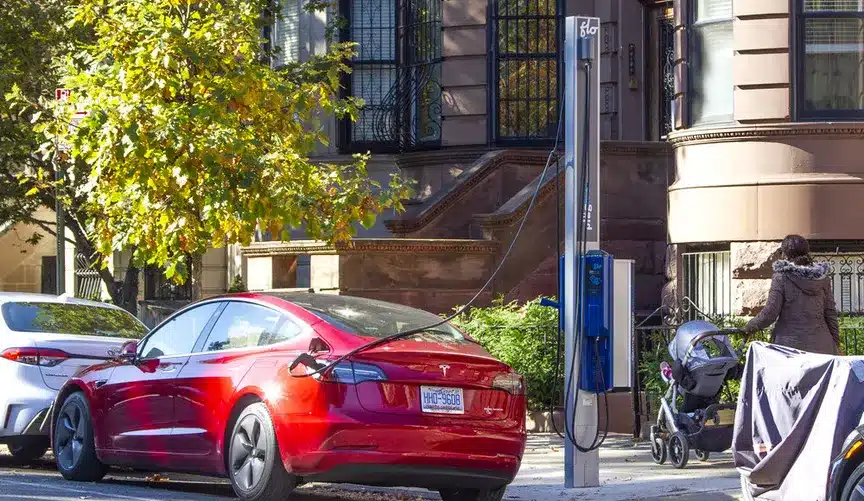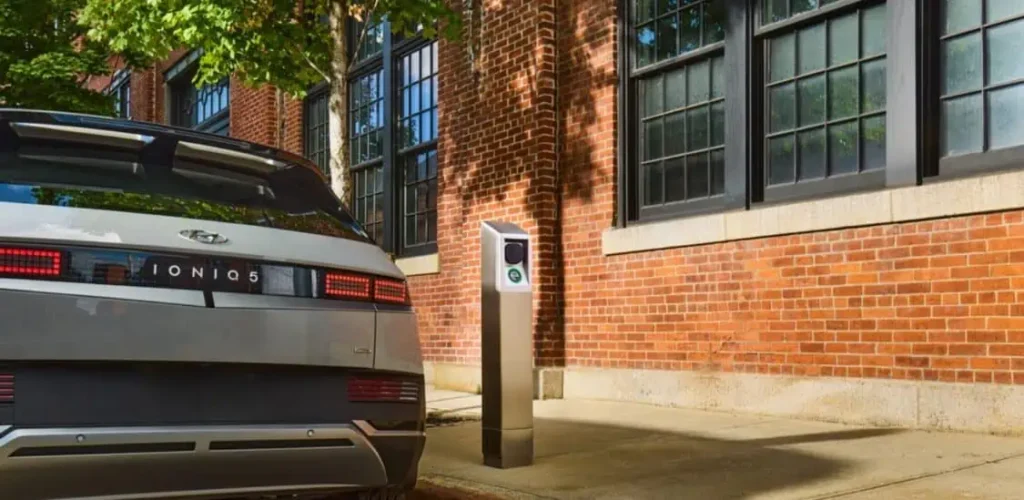NYC to Install 600 Curbside EV Chargers With a $15M Federal Grant
New York City’s plan to expand electric vehicle (EV) charging infrastructure just received a significant boost with a $15 million federal grant aimed at creating 600 curbside chargers, making it the largest network of its kind in the U.S. This initiative is a crucial part of the city’s broader goal to install 10,000 curbside chargers by 2030, helping to ease one of the biggest challenges EV owners face: finding convenient charging spots.
This move is aligned with both local and state-wide goals to reduce transportation-related greenhouse gas emissions, which account for 30% of New York City’s emissions, largely from passenger cars. The city’s transition to electric and wheelchair-accessible vehicles, particularly for for-hire fleets, is a cornerstone of its sustainability efforts. Additionally, this expansion helps prepare for the 2035 statewide mandate that bans the sale of new gas-powered vehicles, accelerating the transition to a cleaner, more sustainable transportation future.
The funding comes from a Biden administration program that has allocated $521 million to EV-charging projects across 28 states, the District of Columbia, and eight Tribes. This initiative reflects growing national efforts to reduce emissions, improve air quality, and make EV ownership more accessible.

New York City’s initial rollout of curbside EV chargers, a pilot program funded by Con Edison, has exceeded expectations. Since launching in 2021, the city has installed 100 chargers next to parking spaces reserved for electric vehicles. These chargers are in high demand, with usage rates topping 70% of the time. The current pricing model charges drivers $2.50 per hour during the day and $1 per hour overnight, making it relatively affordable to top off EV batteries.
With plans to add 600 more chargers using the same pricing model, New York City is aiming to scale up the program. However, there are challenges. The initial deployment, using FLO chargers, involved costly underground construction and power line connections, which, at $13.4 million for just 60 chargers over six years, is nearly as expensive as the $15 million federal grant allocated for the next wave of installations. The need to streamline this process is clear if the city hopes to meet its ambitious goal of 10,000 curbside chargers by 2030.
Exploring more affordable and less labor-intensive methods will be critical. This might include experimenting with different charging technologies, finding ways to simplify the permitting process, or working with other partners to reduce construction costs. Expanding the charging network in a cost-effective way will be essential to supporting New York City’s growing population of EV owners and achieving its long-term sustainability goals.
Itselectric Connects Chargers to Buildings
An alternative approach for expanding EV charging infrastructure in New York City is connecting chargers directly to buildings, a model used by the company Itselectric. This method taps into the electricity already flowing to buildings, which eliminates the need for expensive and time-consuming digging and underground wiring typically required for curbside installations.

“We need chargers on the street, and this is what’s going to enable the transition to electric vehicles,” said Tiya Gordon, co-founder of Itselectric, a Brooklyn-based company that makes and installs curbside chargers in cities.
According to Itselectric, each of their chargers costs less than $10,000 to install, a significantly lower price than traditional chargers like those used in the city’s initial pilot program. By adopting this model, the city could deploy more than twice the number of chargers within its $15 million budget, offering a more cost-efficient and scalable solution for reaching the 10,000 curbside charger goal by 2030.
This building-connected charging model could also be particularly beneficial in dense urban environments like New York, where space is limited and gaining permits for street construction can be a lengthy process.
“The power is already there at the exact right level, because Level 2 charger is the same as an electric dryer or electric oven that you would put into that building,” Gordon said, referring to the standard charging level that curbside chargers use. “That allows us to deploy chargers literally anywhere there’s a building and a curb.”
Voltpost Pilot Project
Voltpost offers another innovative solution for expanding EV charging infrastructure in New York City by converting lampposts into EV chargers. This method drastically reduces installation costs because it avoids the need for digging and expensive underground construction. Instead, Voltpost upgrades the electrical capacity of existing streetlights from 150 to 240 volts, which can be accomplished by adding a single wire to the lamppost. This makes the process far quicker and cheaper than conventional methods.
According to Jeff Prosserman, founder of Voltpost, the company can retrofit a lamppost in just one to two hours. While he didn’t disclose specific per-charger costs, Prosserman is confident that 600 chargers could be installed within the city’s $15 million budget. This approach offers a promising, scalable way to increase EV charging availability in dense urban environments like New York, where space is limited and traditional construction can be both time-consuming and costly.
Voltpost and Itselectric Will Apply to DOT
Though Itselectric and Voltpost are not yet formally involved in New York City’s EV charging expansion, both companies plan to apply to the Department of Transportation (DOT) once the city issues a request for proposals. A timeline for construction is expected to be announced later this year. The goal is for these new curbside chargers to encourage more of the city’s car owners to switch to electric vehicles (EVs).
Despite New York City’s extensive public transit system, nearly half of its households still own a car. Decarbonizing the city’s transportation sector, including private cars, taxis, buses, trucks, and delivery vans, will require a robust charging infrastructure. This is essential if the city hopes to meet its climate goals and shift its vehicle fleets away from gasoline-powered engines.
As Jeff Prosserman of Voltpost pointed out, ensuring that all these vehicles have access to reliable charging options is critical for the transition from gas to electric. Expanding the curbside charging network, in combination with other efforts, is key to making EV ownership viable for a larger portion of New Yorkers, supporting the city’s larger decarbonization efforts.

Electric Vehicle Marketing Consultant, Writer and Editor. Publisher EVinfo.net.
Services